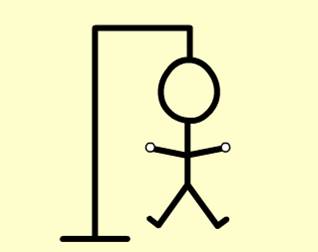Until Death Does the Hangman Part

Here’s a myth you don’t want to test out, in part because you’ll have to commit a really brutal crime, and in part because it won’t work out for you in the end. Many people think that if a person convicted of a capital crime and condemned to death, the state has only one chance to carry out that punishment. Or in other words, if you’re given the death penalty but somehow survive, you’re allowed to go free. That’s not true — they’ll just try again another day.
But just to be on the safe side, for the last couple of centuries, death warrants have made that clear, typically stating that the method of execution is to be carried out “until death” occurs. The hope is that such level of specificity won’t be needed, of course, but as recently as 1984, it was. Mental Floss explains:
In 1984, the state of Georgia executed Alpha Otis O’Daniel Stephens for the murder of a man who interrupted Stephens during a burglary 10 years earlier. The first jolt of electricity from the electric chair failed to kill him, and Stephens sat in the chair, alive and, by some accounts, semi-conscious, for six minutes while his body cooled enough for doctors to examine him and decide another jolt was needed.
That’s the exception, though, not the rule. Most forms of execution are designed to kill as quickly and painlessly as possible (although that’s a much deeper debate and one for a different publication, for that matter). As a result, incomplete executions (for lack of a better term) should be extraordinarily rare. But that wasn’t always the case. Hanging, in particular, was problematic for generations. Nowadays, hanging kills nearly instantly, snapping the person’s neck. (Let’s not go into details.) Turn back the clock to the 1700s, though, and the opposite was true. The executioner placed a noose around the convicted person’s neck and let him or her dangle until he or she died from strangulation. That could take twenty or more minutes in extreme cases.
A Scottish woman named Margaret Dickson, hanged in 1724, was one of those cases. Like many news items from the early 18th century, history is light on the details, but in most versions of the story, Dickson was accused and convicted of having an illegitimate child and then murdering the baby to hide her sin. She was hanged in Grassmarket, then a marketplace in Edinburgh, Scotland, and now a town center. An academic paper on the history and the biomechanics of hanging (here’s a pdf, and yes, someone wrote an academic paper on that topic) summarized what happened next:
The hangman had to drag down her legs to ensure death, and left her hanging for a prolonged period of time. Her friends succeeded in taking her from surgeons who wanted to take the body to anatomists; while accompanying the cart to Musselburgh [a village about five miles from Edinburgh] for burial, they were surprised, as Margaret started showing signs of life. By the time they reached their destination, Dickson was almost fully revived.
Dickson — regardless of what version of the story being told — wasn’t re-hanged. Instead, she was set free and went on to live a rather productive life.
Why not just hang her again? In part, she was spared because the townsfolk were convinced that she was given a divine pardon, and us humans shouldn’t mess with that. That said, not everyone was convinced that the judge up on high had rendered a different verdict than the terrestrial court. But really, that didn’t matter, as the law at the time didn’t specify that she was to be hung “until death.” It simply required that she be hanged, which she was. As Wikipedia notes, “under Scots Law, her punishment had been carried out, she could not be executed for a second time for the same crime.”
Again, to be clear: that loophole has been fixed.
Bonus fact: In the United States, we tend to think of hanging as a long-gone method of execution. (The above-linked Mental Floss article, for example, asserts that “we’ve moved beyond firing squads and hangings.”) But it’s still around. The last time a person was executed by hanging in the United States was 1996 when Delaware ordered that convicted murderer Billy Bailey be hanged until he was dead. While Delaware courts have since outlawed the death penalty altogether, there’s still a chance that Bailey won’t be the last person in the United States to be hanged — hanging is still a legal method of execution in New Hampshire, and was until a few days ago when the Supreme Court of the state of Washington outlawed capital punishment.
From the Archives: Hangman’s Most Difficult Word: If you’re playing the game Hangman, here’s a scientifically-demonstrated way to win (unless too many people read that article, in which case, sorry.)
